
|

|
For the rehabilitation of pipes, the mechanical and thermal properties are of special importance. | |
These properties determine the bending radius of the pipes during lining processes with continuous pipes as well as the tensile strength or buckling strength when external fluid pressure is imposed on all sides during annular space grouting, for example. | |
Thermoplastics are of excellent chemical resistance. They are resistant to all known types of soil … |
|
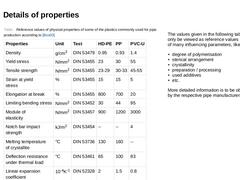
|

(Table: Reference values of physical properties of some of the plastics commonly used for pipe production according to [Bos00]) |
The values given in the following table can only be viewed as reference values because of many influencing parameters, like e.g. - degree of polymerisation
- sterical arrangement
- crystallinity
- preparation / processing
- used additives
- etc.
More detailed information is to be obtained by the respective pipe manufacturer. |
|
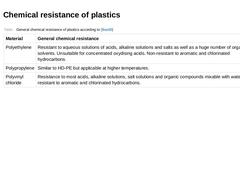
|

(Table: General chemical resistance of plastics according to [Bos00]) |
|

|

|
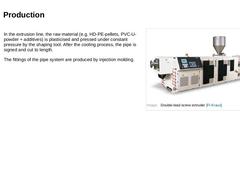
|

| (Image: Double-lead screw extruder [FI-Kraus])
In the extrusion line, the raw material (e.g. HD-PE-pellets, PVC-U-powder + additives) is plasticised and pressed under constant pressure by the shaping tool. After the cooling process, the pipe is signed and cut to length. The fittings of the pipe system are produced by injection molding. |
|
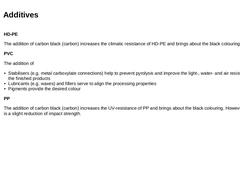
|

|
HD-PE The addition of carbon black (carbon) increases the climatic resistance of HD-PE and brings about the black colouring. PVC The addition of - Stabilisers (e.g. metal carboxylate connections) help to prevent pyrolysis and improve the light-, water- and air resistance of the finished products
- Lubricants (e.g. waxes) and fillers serve to align the processing properties
- Pigments provide the desired colour
PP The addition of carbon black (carbon) increases … |
|
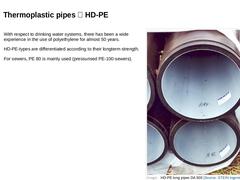
|

Thermoplastic pipes - HD-PE |

|

|
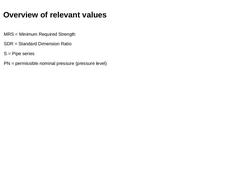
|

|
MRS = Minimum Required Strength SDR = Standard Dimension Ratio S = Pipe series PN = permissible nominal pressure (pressure level) |
|
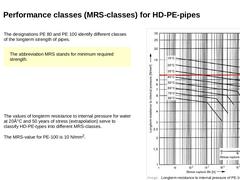
|

|
The designations PE 80 and PE 100 identify different classes of the longterm strength of pipes. | (Image: Longterm resistance to internal pressure of PE-100-pipes)
| |
The abbreviation MRS stands for minimum required strength. | |
The values of longterm resistance to internal pressure for water at 20°C and 50 years of stress (extrapolation) serve to classify HD-PE-types into different MRS-classes. The MRS-value for PE-100 is 10 N/mm2. |
|

|

(Table: Performance classes (MRS-classes) for HD-PE-pipes) | | (Image: Longterm resistance to internal pressure of PE-80-pipes)
| (Image: Longterm resistance to internal pressure of PE-100-pipes)
|
|
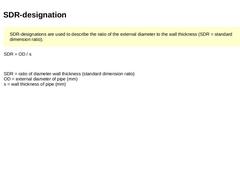
|

|
SDR-designations are used to describe the ratio of the external diameter to the wall thickness (SDR = standard dimension ratio). | |
SDR = OD / s
SDR = ratio of diameter-wall thickness (standard dimension ratio)
OD = external diameter of pipe (mm)
s = wall thickness of pipe (mm) |
|
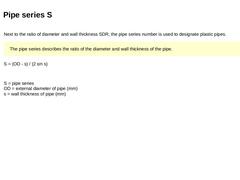
|

|
Next to the ratio of diameter and wall thickness SDR, the pipe series number is used to designate plastic pipes. | |
The pipe series describes the ratio of the diameter and wall thickness of the pipe. | |
S = (OD - s) / (2 ยท s)
S = pipe series
OD = external diameter of pipe (mm)
s = wall thickness of pipe (mm) |
|

|

|
The predetermined external diameter of the pipe and the closely related wall thicknesses lead to the following correlation between the pipe series S and the standard dimension ratio SDR:
S = (SDR - 1) / 2 ⇒ SDR = 2 · S + 1
S = pipe series
SDR = standard dimension ratio
OD = external diameter of pipe (mm)
s = wall thickness of pipe (mm) |
|

|

|
The dimensioning of plastic pipes is carried out on the basis of the minimum strength and a security factor. The security factors depend on the type of application and the hazard risk. DIN 8074 suggests three different security factors SF (1.25, 1.6 und 2.0) for HD-PE. Using the design coefficient C, DIN EN ISO 12162 only defines two different security factors (1.25 for water pipes; 2.0 for gas pipes). A low security factor increases the operating … |
|

|

| (Image: Attention!)
The previously used term "PN" = "nominal pressure" has been taken out of the German standards for plastic pipes and is not used anymore. | |
The nominal pressure depends on the wall thickness and on the diameter of the pipe as well as on the applied security factor. PN = (20 ยท MRS) / ((SDR - 1) ยท SF)) = (10 ยท MRS) / (S ยท SF)
PN = maximum permissible nominal pressure (bar)
SDR = standard dimension ratio (OD/s)
MRS = minimum required … |
|

|

|
In order to illustrate this change, the pipe series S and the diameter/wallthickness ratios SDR are compared with the previous PN-values in the following table. (Table: Correlation between S, SDR and PN [DIN8074b]) |
|
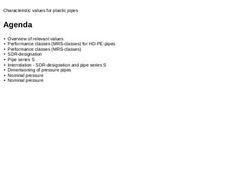
|

|

|

| (Image: HD-PE-pipe on a as coil reel)
Seamlessly extruded HD-PE-pipes are manufactured according to DIN 8074/75 with an external diameter of up to 1.600 mm and for nominal pressures between PN 2.5 and PN 16 depending on the limits of the wallthicknesses. The pipes are standardised according to their external diameters. The internal diameter is thus determined by the respective wallthickness of the pipe. | | (Image: Attention!)
Pipes with an external … |
|

|

|
The choice of the wall thickness depends on the effective stresses. For the rehabilitation of unpressurized sewers, the pipes must have the required ring stiffness and buckling strength according to ATV M 127-2 in order to be placed below groundwater and to be used for annular space grouting. (Image: Liner under external pressure)
|
|

|

|
In groundwater and during annular space grouting, hydrostatic load is imposed on the lining pipe. This pressure must not be higher than the permissible buckling pressure Pk,perm of the pipe. |
(Image: Buoyancy force Fv with reference to [FI-Hoech] [Koch85] [Bild: S&P GmbH])
|
(Image: Buckling of the liner during annular space grouting)
|
|
|
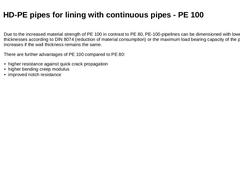
|

|
Due to the increased material strength of PE 100 in contrast to PE 80, PE-100-pipelines can be dimensioned with lower wall thicknesses according to DIN 8074 (reduction of material consumption) or the maximum load bearing capacity of the pipe increases if the wall thickness remains the same. There are further advantages of PE 100 compared to PE 80: - higher resistance against quick crack propagation
- higher bending creep modulus
- improved notch resistance
|
|
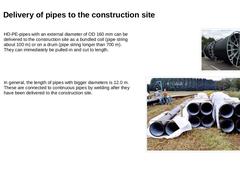
|

|
HD-PE-pipes with an external diameter of OD 160 mm can be delivered to the construction site as a bundled coil (pipe string about 100 m) or on a drum (pipe string longer than 700 m). They can immediately be pulled-in and cut to length. | (Image: HD-PE-pipe on a as coil reel)
| |
In general, the length of pipes with bigger diameters is 12.0 m. These are connected to continuous pipes by welding after they have been delivered to the construction site. | (… |
|

|

|
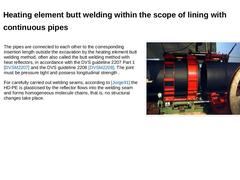
|

| (Image: Conventional sliplining process with annular space [FI-Teerb] - Welding of HD-PE pipes outside the excavation with the heating element butt-welding process)
The pipes are connected to each other to the corresponding insertion length outside the excavation by the heating element butt welding method, often also called the butt welding method with heat reflectors, in accordance with the DVS guideline 2207 Part 1 [DVSM2207] and the DVS guideline … |
|